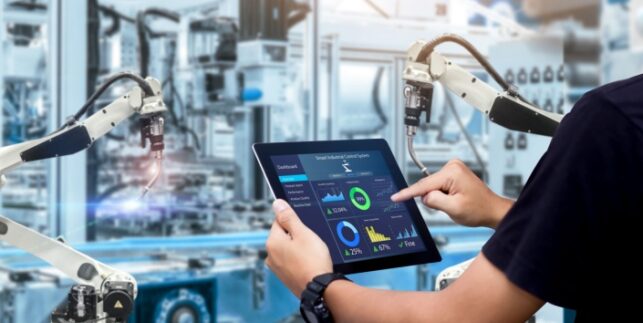Why Digital Manufacturing Dashboards Matter for Industry 4.0

Industry 4.0 is all about tracking rapid real-world changes and using them to improve the productivity and profitability of your factory. Naturally, data is key to this process, and so are manufacturing dashboards.
A good manufacturing analytics dashboard translates the endless stream of data delivered by real-time monitoring systems into easy-to-understand visual displays and clear actionable insights. It serves as a bridge between the software and its human user, and it is arguably the most important component of any shop floor control software.
The Evolution of the Manufacturing Dashboard
Manufacturing dashboards have existed for decades, however, their functionality was not as robust as what exists today. Early dashboards were static, one-size-fits-all solutions that could only be accessed using a desktop computer. Information displayed was generic to all users, and data was updated at long intervals. Though these tools were state-of-the-art at the time, they lacked the agility and analytical power needed to live up to their full potential.
A manufacturing dashboard must do much more than display yesterday’s news; It must bring users the newest and most relevant insights and use AI functionality to add context to that information. It must also augment your monitoring efforts with real-time alerts that ensure you always have the knowledge required to succeed. It should allow you to communicate with your team within the context of a single job, improving visibility and transparency on the shop floor. You can even delegate tasks right from the central hub, all on an easy-to-use mobile-accessible platform.
A modern manufacturing analytics dashboard is not only a static display but a dynamic, real-time operational intelligence tool. Using built-in management controls, per-job internal communication features, automated event flows, and predictive insights, it allows the user to optimize a factory from top to bottom.
Unique Dashboards for Every Role
A truly useful visual factory dashboard is tailored to the user’s needs, providing them with the exact information they require at the precise moment in which it is most pertinent. Customizable dashboards can be set up to facilitate the work of every staff member inside a factory.
Here’s what this looks like in practice for some common factory roles:
For Planners
Production planning is largely a future-focused role, but like any factory job, immediate concerns also have an impact on the work. Planners can do their best work when they have access to balanced amounts of historical and real-time data. Their dashboards should give them access to analytics tools that will help them identify long-term trends and guide data-driven decision-making. Real-time data feeds from multiple systems and devices can then give planning feedback and reveal weak points in the factory’s current operations.
Planners can use real-time data from a production performance dashboard to keep up with moment-to-moment shifts in materials purchasing, order scheduling, demand forecasting, and more. Armed with this information, a planner can make proactive moves that benefit the plant, such as order a more-than-usual quantity of material(s) or adapting their output expectations based on current factory conditions.
For Managers
Much like planners, managers require a constant stream of high-level production information. However, a manager’s job is much more immediate and reactive. To be effective in their role, managers must understand the implications of incoming production data and quickly devise a plan of action around those insights. Without the right information at the right time, they cannot make informed decisions to guide production.
A manager’s manufacturing KPI dashboard should continually show updated shift reports by machine, department, or factory as needed. Each of these reports should contain metrics such as:
- Machine availability
- OEE KPI
- Production rate
- Scrap rate
However, managers in different facilities may need access to a unique set of metrics to do their job. To accommodate this, the dashboard should offer customization features that allow metrics to be added or subtracted from the default settings as required.
To increase reaction times and minimize production disruptions, the dashboard should also display automatic alerts to notify managers of possible problems related to data discrepancies. Finally, it must include support for team messaging on a job-to-job basis, including the ability to assign tasks to individuals or groups as needed throughout a shift.
For Operators
For operators, nothing happening on the floor matters more than the work right in front of them. For this reason, their dashboards should be as clear and concise as possible. They should prioritize visual display to make it easy for operators to process the information without being distracted from the current task.
Customizable dashboards can provide clear and relevant feedback on the operator’s performance using metrics such as:
- Cycle time
- Machine uptime
- Units produced
- Production plan status
Operators can compare this data to standard parameters displayed on the screen to gauge how well they are doing. Alerts for localized production events such as low material weight, high cycle times, or machine stoppages underscore the importance of taking action in critical moments.
For Quality Control
Quality control managers must work with both historical and real-time data to achieve optimal outcomes. Their dashboards should offer instant, detailed feedback on common QC measurements such as:
- First-pass yield
- Scrap rate
- Supplier defect rate
QC dashboards should also employ alerts to draw users’ attention to data deviations that may be the first signs of a growing problem. They can use this information to monitor and enforce operational efficiency, reduce waste, and improve the factory’s overall quality.
Powerful analytics tools on an OEE dashboard give QC professionals the ability to perform statistical process control in online and offline contexts. This enables them to ensure that repeatable processes are performed consistently and produce reliably high-quality outputs.
For Technicians
Technicians must focus on a very specific set of metrics to perform optimally in their role. For this reason, they need access to reports on machine performance, including contextually relevant information about machine disruptions and work stoppage events.
When machine performance begins to slow or significant numbers of poor quality products emerge from a particular line, technicians know that those machines may need attention. Their real-time manufacturing dashboard should alert them to these events and give them tools to analyze the reasons behind the problem and prevent similar future occurrences. This should include a tool to communicate with the plant’s operators since those workers typically witness work stoppages and disruptions first-hand.
The technician’s dashboard should also provide access to machine maintenance and auditing schedules they can review to learn when a machine was last serviced. Alerts for machines that are past due for inspection help them stay on top of maintenance schedules and minimize breakdowns.

Changing the way people work in factories
Request a DemoDynamic Dashboards Drive Manufacturing Excellence
Even the best shop floor control software will underperform without the right digital dashboard. You and your team need a centralized data solution to monitor your plant’s real-time data, automatically parse it into useful information, and instantly communicate to coordinate effective solutions.
Dynamic digital dashboards bring all of these functions together into a single RtOI solution
Matics’ digital dashboards are designed with modern manufacturing in mind and offer:
- Bold yet simple graphic data displays
- Full data integration across multiple software solutions
- Continual data aggregation and analysis
- Customizable interfaces
- Automation tools triggered by pre-set conditions
- Factory-wide and job-specific chat channels
- Instant alerts for problematic data discrepancies
- Scalability to suit operations of any size
- Mobile accessibility
… and much more!
Your Matics dashboard has everything you need to optimize operations in your facility. Contact us for more information on our dashboard setup or book a demo of our industry-leading software.




